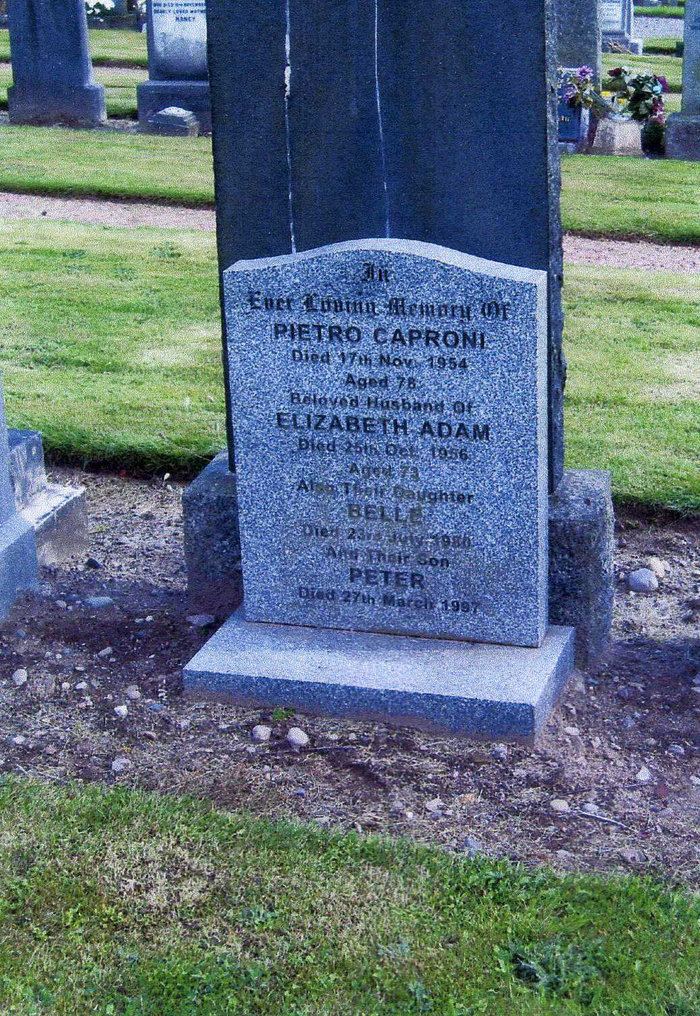Name Pietro Caproni | Died 1928 | |
 | ||
Pietro Paulo Caproni (1862 – 1928) was founder and co-owner of PP Caproni & Brother, Boston, Massachusetts, manufacturers of plaster reproductions of classical and contemporary statues. These 'cast' reproductions were, in an era before commercial photography, an integral educational tool in teaching people the history of art and antiquities.
Together with his brother, Emilio, the Caproni brothers supplied art schools, major universities and museums in the United States and abroad with quality reproductions. The firm operated under their ownership between 1892 and 1927, the year the company was sold and a year before Pietro's death.
Before World War II major United States museums had cast collections, including the Metropolitan Museum of Art in New York City and Boston's Museum of Fine Arts. Although Caproni did not supply these museums with their casts, he did supply other museums with their casts, and they included:
University collections which the Caproni firm installed included those at Harvard University, Yale University, Princeton University, Cornell University, and Emory University. Art schools such as the Pennsylvania Academy of Fine Arts used Caproni casts as models for their art students to draw from.
Additional installations of Caproni Casts were in leading hotels, theaters, and concert halls. The Loews theatre chains of the early 19th century featured Caproni casts, as did Symphony Hall, Boston and the atmospheric theaters designed by John Eberson.
Rising sculptors of the time sought the expertise of the Caproni studios when creating some of the country's best known civic sculpture. Among them was Cyrus Edwin Dallin, whose Appeal to the Great Spirit and Paul Revere, both of which are standing in Boston, were modelled in the Caproni studios' basement. Other known artists who worked with the Caproni Brothers include Daniel Chester French, Loredo Taft, and Leonard Craske which was made famous on TV commercials for 'Gordon's of Gloucester' fishsticks in the 1970s and 1980s. Caproni worked with these sculptors to model the original plasters before these major pieces went to a bronze foundry.
When Pietro Caproni arrived in Boston in the 1870s he was apprenticed to Paul A Garey, whose plaster statuary company dated back to 1834. Pietro and Emilio bought the company in 1892 and quickly starting building a new studio and workspace at 8 Newcomb Street in Roxbury. In 1896 they purchased two brownstone buildings on 1920 Washington Street, and connected all three buildings with a 5,000-square-foot (460 m2) gallery space to showcase their work. By 1900 the two brownstone buildings facing Washington Street were re-faced to appear as one building and an enclosed bridge connected them to the Newcomb Street building behind. The company issued catalogues most every year between 1892 and 1915. Hard-cover catalogues were published in 1901 and 1911, the latter being the largest and most complete catalogue ever published by the company and was used by schools as a guide to identifying antiquities. After 1915 soft-cover catalogues were published in 1922 and 1928. The company changed ownership, and names, frequently between 1928 and 1950's, most of its owners falling into receivership due to lack of sales and interest in what were widely perceived as 'only copies'. Lino Giust bought the Washington Street buildings in 1970 and operated them as the Giust Gallery until his retirement in 1995. Today the buildings are condominium homes.
Caproni casts can be identified by a metal hallmark imbedded into the base of the cast. Early casts have brass hallmarks bearing "PP CAPRONI & BROTHER PLASTIC ARTS, BOSTON, MA." In later years the medium changed to aluminum. In 1932 the company changed names to 'Caproni Galleries, Inc' and was a supplier to Disney for the plaster figurines of all the Disney characters. Amadeo Nardini, owner of a casting company which specialized in ecclesiastical subjects, bought the company around 1940 and ran it as "Caproni Galleries of Amadeo."
Pietro was born in Barga, Italy and left Italy for Boston in the late 1870s. His first marriage to Jane M. Stayner produced four children and the marriage ended in divorce. His second wife and later widow, Gertrude Brinkhaus, was an advocate of art in Public Schools and later saw through her husband's wish to bequest a Maternity Wing to the Barga Hospital, at the time the largest private gift to the Italian people, as acknowledged by Benito Mussolini. Pietro and Gertrude are buried at Forest Hills Cemetery]in Boston's Jamaica Plain neighborhood. The Sleeping and Awakening Lion statues are based on Antonio Canova's design for the Tomb of Pope Clement XIII in Rome.
In 1993, Robert Shure purchased the entire Caproni Collection and the business rights to the Giust Gallery. Until 2003, the Washington Street address was still rented from Mr. Giust although most of the pieces were cast at a new location offsite since 1993. In 2006, a small gallery was set up at 105 Salem Street in Woburn Massachusetts where the pieces are all made by hand continuing to use traditional methods of plaster casting and are shipped all over the world. The new owner, Robert Shure, a plaster cast and bronze expert, restoration expert, and sculptor in his own right, has recovered many more original vintage Caproni casts and greatly enlarged the collection. The company is now flourishing and has supplemented the cast collections of many locations including the Pennsylvania Academy of Fine Arts and The Jerusalem Studio School in Israel. They have also recently added the full sized Victory of Samothrace back into the collection and a copy now occupies the Darwin D. Martin House (designed by Frank Lloyd Wright) in Buffalo, New York as a replacement for the original one placed there by Mr. Wright. Art schools and ateliers across the USA and beyond now use their anatomical casts for their drawing/sculpting classes. Discerning designers and collectors of historical casts are also among those who collect these museum quality castings. The collection can be seen online at www.giustgallery.com.
